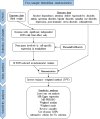Exploring the causal effect of placental physiology in susceptibility to mental and addictive disorders: a Mendelian randomization study
- PMID: 39135989
- PMCID: PMC11317394
- DOI: 10.3389/fpsyt.2024.1396837
Exploring the causal effect of placental physiology in susceptibility to mental and addictive disorders: a Mendelian randomization study
Abstract
Background: Epidemiological studies have linked low birth weight to psychiatric disorders, including substance use disorders. Genomic analyses suggest a role of placental physiology on psychiatric risk. We investigated whether this association is causally related to impaired trophoblast function.
Methods: We conducted a two-sample summary-data Mendelian randomization study using as instrumental variables those genetic variants strongly associated with birth weight, whose effect is exerted through the fetal genome, and are located near genes with differential expression in trophoblasts. Eight psychiatric and substance use disorders with >10,000 samples were included as outcomes. The inverse variance weighted method was used as the main analysis and several sensitivity analyses were performed for those significant results.
Results: The inverse variance weighted estimate, based on 14 instrumental variables, revealed an association, after correction for multiple tests, between birth weight and broadly defined depression (β = -0.165, 95% CI = -0.282 to -0.047, P = 0.0059). Sensitivity analyses revealed the absence of heterogeneity in the effect of instrumental variables, confirmed by leave-one-out analysis, MR_Egger intercept, and MR_PRESSO. The effect was consistent using robust methods. Reverse causality was not detected. The effect was specifically linked to genetic variants near genes involved in trophoblast physiology instead of genes with fetal effect on birth weight or involved in placenta development.
Conclusion: Impaired trophoblast functioning, probably leading to reduced fetal brain oxygen and nutrient supply, is causally related to broadly defined depression. Considering the therapeutic potential of some agents to treat fetal growth restriction, further research on the effect of trophoblast physiology on mental disorders may have future implications in prevention.
Keywords: Mendelian randomization; birth weight; depression; fetal neurodevelopment; mental disorders; placental physiology; psychiatric genetics; trophoblast invasion.
Copyright © 2024 Jácome-Ferrer and Costas.
Conflict of interest statement
The authors declare that the research was conducted in the absence of any commercial or financial relationships that could be construed as a potential conflict of interest.
Figures






Similar articles
-
[Genetic Causation Analysis of Hyperandrogenemia Testing Indicators and Preeclampsia].Sichuan Da Xue Xue Bao Yi Xue Ban. 2024 May 20;55(3):566-573. doi: 10.12182/20240560106. Sichuan Da Xue Xue Bao Yi Xue Ban. 2024. PMID: 38948277 Free PMC article. Chinese.
-
Causality of genetically determined metabolites on anxiety disorders: a two-sample Mendelian randomization study.J Transl Med. 2022 Oct 20;20(1):475. doi: 10.1186/s12967-022-03691-2. J Transl Med. 2022. PMID: 36266699 Free PMC article.
-
[Mendelian randomization of the causal relationship between ω-3 polyunsaturated fatty acids and major depression].Wei Sheng Yan Jiu. 2023 Sep;52(5):793-800. doi: 10.19813/j.cnki.weishengyanjiu.2023.05.018. Wei Sheng Yan Jiu. 2023. PMID: 37802905 Chinese.
-
Mendelian randomization analysis reveals a causal relationship between preterm birth and myopia risk.Front Pediatr. 2024 Jul 18;12:1404184. doi: 10.3389/fped.2024.1404184. eCollection 2024. Front Pediatr. 2024. PMID: 39091988 Free PMC article.
-
Ankylosing spondylitis and psychiatric disorders in European population: a Mendelian randomization study.Front Immunol. 2023 Oct 26;14:1277959. doi: 10.3389/fimmu.2023.1277959. eCollection 2023. Front Immunol. 2023. PMID: 37954601 Free PMC article.
Cited by
-
Hypoxia in extravillous trophoblasts links maternal obesity and offspring neurobehavior.iScience. 2025 May 12;28(6):112636. doi: 10.1016/j.isci.2025.112636. eCollection 2025 Jun 20. iScience. 2025. PMID: 40502709 Free PMC article.
References
LinkOut - more resources
Full Text Sources

